Do you make these September garden mistakes?
I sense that the September garden isn’t anyone’s favourite.
Vita Sackville-West abandoned Sissinghurst for the Mediterranean in September. Alan Titchmarsh refers to ‘the depths of September and October’. There’s a distinct drop in the number of gardens open via the NGS. And so on.
But is the September garden intrinsically difficult? Or is it just too far away from the excitement of spring, early summer and the big flower shows? Then we go on holiday, and when we come back…
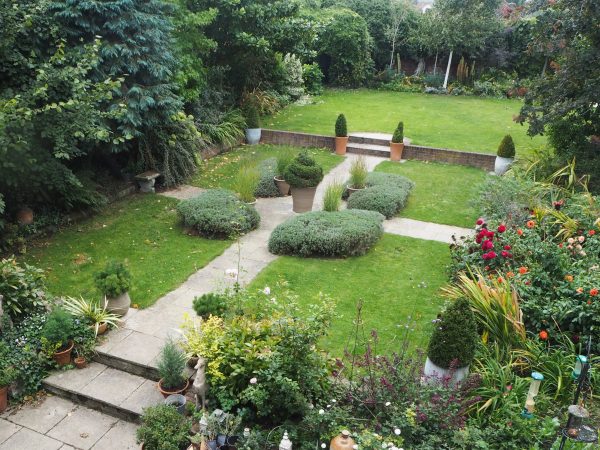
The Middlesized Garden in September. The main colour border is on the right, with dahlias.
But one of the great pluses of doing a garden tour – in blog, video or personal diary – is that it makes you focus on what’s really going on now. And now is almost the end of September.
So let’s have a tour of my September garden mistakes. They may help you too.
Mistake 1 – made last autumn!
You can’t fault September gardens on colour. I’m passionate about dahlias, and they are at their best now. But I have learned some very useful lessons about them this year.
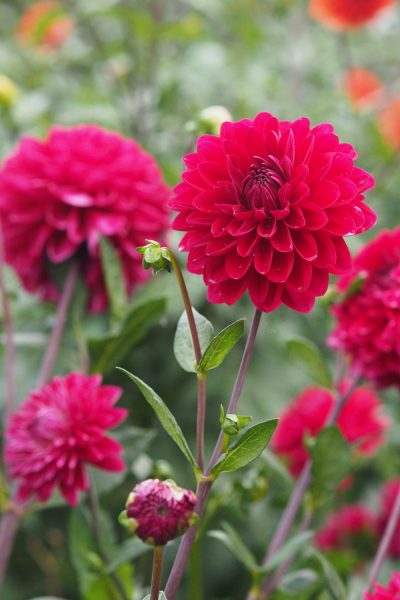
Dahlia ‘Con Amore’. It was mulched last winter. I think it’s planning to take over the world. Dahlias are at the heart of my September garden but perhaps I should go for a wider colour range?
We’re in Kent, which is roughly a USA hardiness zone 8b. So I don’t dig up dahlias. I cut them down and mulch them. However last year I got distracted halfway through and only mulched half of them.
The mulched dahlias survived, bigger and better than ever. The dahlias that weren’t mulched either died or emerged late, looking very much smaller. After I talked about this on my August garden video tour, several fellow bloggers commented that their dahlias had also suffered from the nine-week drought through the summer.
Healthy plants which have been mulched or fed survive drought better than those which are a bit underfed. It stands to reason, doesn’t it?
But it was clearly a double whammy for the un-mulched dahlias in this year’s September garden. Last year I had a bed packed with dahlias of varying but roughly equal heights. Now I have a bed of very large and very small dahlias. And the small dahlias are in the middle of the bed, ringed by the large ones. It looks like a collapsed souffle.
Mistake 2 – not re-thinking colour regularly
Video-ing and photographing the garden on a month-by-month basis also helps me focus on how colour is working. I have dark red ‘Rip City’ dahlias, hot pink ‘Con Amore’ and an orange dahlia that no-one seems to be able to identify. The orange one is very vigorous. I do wonder if it’s accidentally regressed from something else. It is currently rioting around the main border, swamping all other plants.
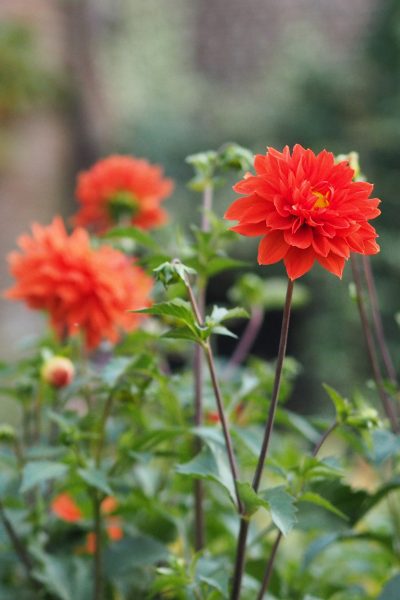
Unknown but vigorous orange dahlia. I put it on Twitter asking for ID and everyone was super-helpful about retweeting it (thank you!) but nobody seems to know.
However, looking at the photographs, I think that red, orange and pink is beginning to look a bit heavy. Next year’s September garden would benefit from some of the shot-silk and sunset patterned dahlias I’ve seen in gardens like The Salutation. I do have the very beautiful coral-peach ‘Henriette’ but it is one of the ones suffering from lack of mulch and is very small this year.
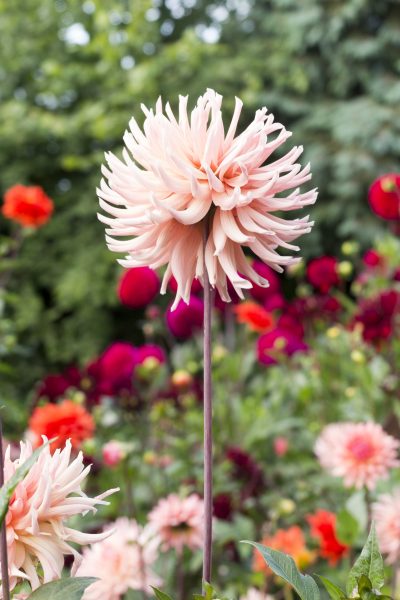
This photo of dahlia ‘Henriette’ standing proud in 2017 really underlines how much this plant has suffered from the 2018 freeze and drought. This year it is barely a foot or so off the ground. I haven’t been able to take any photos of it, because the flowers themselves look a bit ragged.
Mistake 3 – not trying anything new
I’ve relied almost wholly on dahlias for my September garden colour. But I can see that I need to expand my planting horizons. recently visited Borde Hill gardens for inspiration on late season planting. I was impressed by Rudbeckia ‘Goldsturm’, which flourished in several very different areas of the garden.
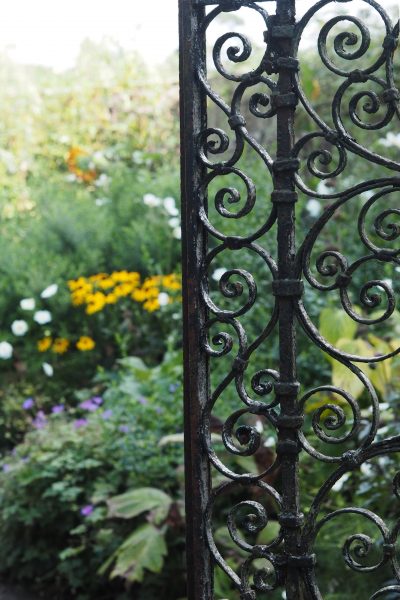
Rudbeckia ‘Goldsturm’ in a herbaceous border at Borde Hill Gardens. ‘Goldsturm’ was also happy in a patch of shady woodland, in an exotic area and amongst perennial grasses. So versatile!
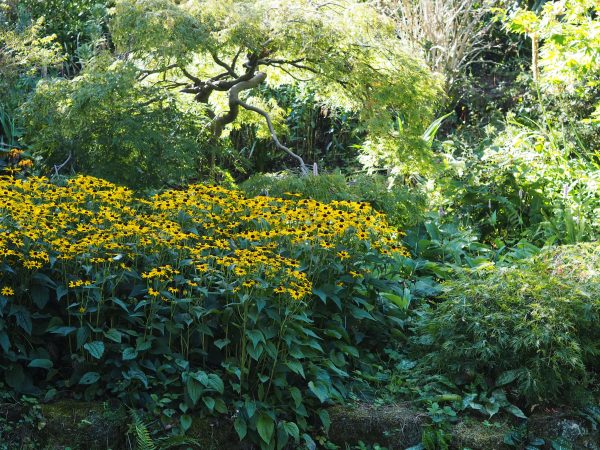
Rudbeckia ‘Goldsturm’ in shady woodland at Borde Hill.
I’d also like to try cannas and persicaria.
Mistake 4 – not taking advice seriously
Back to the Middlesized Garden again. I do take advice. Honestly. But I’ve decided that advice falls into three categories. There’s advice you simply have to take. If you don’t, it doesn’t work. Whatever it is (gardening, blogging, marathon running…)
Then there’s advice that is basically a counsel of perfection. You should take it, but lots of people manage to muddle along without doing so.
And there is advice that might have worked once, and has become enshrined in folklore. But eventually someone does some proper testing on it, and decides that even if it mattered once it doesn’t any more. I am thinking of the tests ‘Which Magazine’ ran on whether you really need crocks in the bottom of pots, for example. They discovered it made no difference.
So it can be difficult to decide which advice to take. Now I have discovered that ‘squash doesn’t like root distubance’ is ‘first category’ advice. I planted two ‘Black Futsu’ squash seeds, then realised they were too close together. But how does a squash know it’s being moved? If I’m very careful? I moved it, trying to persuade the squash that absolutely nothing was happening…
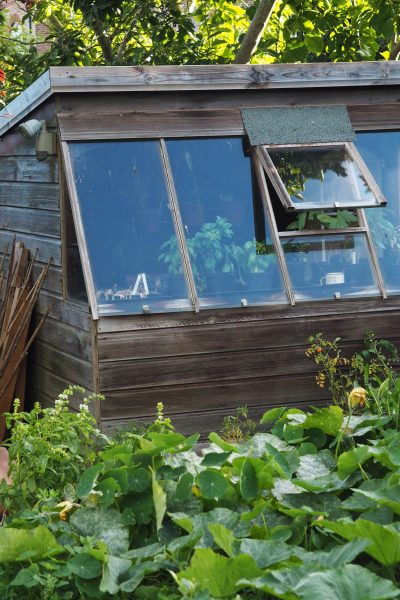
The mound of leaves in the foreground is ‘Black Futsu’ squash. A few feet away is its much smaller twin, literally a third of the size.
Ha! The squash left in its original place is more than three times the size of the one I moved three feet away. If the seed packet says a ‘curcubit’ (squash, cucumber, courgette) doesn’t like root disturbance, it really means it.
And should you clip roses with shears or prune with secateurs?
This isn’t so much a mistake as a choice. I have a row of ‘Cecile Brunner’ roses. They are quite time-consuming to dead-head so I did one side with secateurs, tackling each stem individually. On the other side, I clipped everything briskly off with shears.
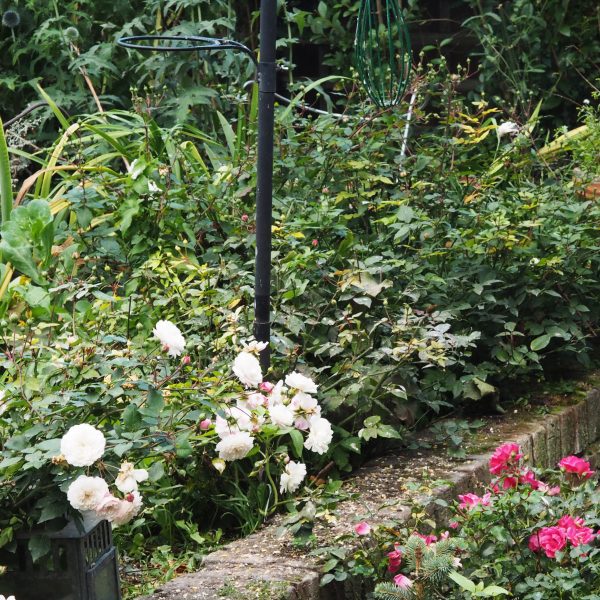
A row of ‘Cecile Brunner’ roses. I clipped the ones to the right of the bird feeder pole with shears. The ones on the left were individually cut with secateurs. That was six weeks ago.
The side that was carefully pruned with secateurs has come back into flower several weeks’ earlier. And it’s a more airy shape. The clipped side, however, has just as many buds – it’s just taking it longer to get there. I suppose it’s a question of what you prefer.
I checked these results with a rosarian. He agreed that roses will come back, whether you prune them with clippers or secateurs. However, he pointed out that if you’re pruning alot of roses, it isn’t necessarily quicker to use shears, because you have to clear up all the fallen rose heads afterwards. ‘When you prune one by one, you throw the discarded heads away as you go.’
Mistake 5 – neglecting your September garden topiary
I actually haven’t made this mistake, as we do sharpen up our topiary around this time every year.
Jake Hobson of Niwaki spoke about pruning topiary at The Landscape Show. While different plants need topiary pruning at different times, he advises sharpening it all up in September. These shapes are so important for the winter.
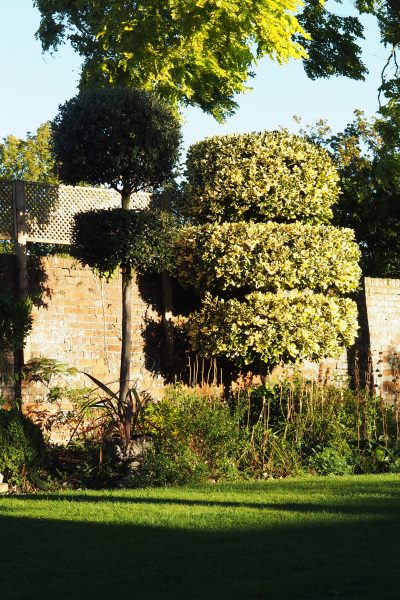
Holly ‘Golden King’ and one of the topiarised holm oaks. They are now about 12ft and 16ft tall respectively.
We planted two holm oaks in 2010. They were just young whips and cost £50 each. It took about 5-6 years to get them into a good topiary shape. And this year (Year 7) is their best cut ever.
We get Salvatore, a topiary expert, to give our trees their hair cut. He has also carved a ‘wedding cake’ shape out of a lump of Holly ‘Golden King.’ It took about 2 years to get this cut crisp, as Salvatore cut it out of a mature bush, and the shape won’t be perfect to start with.
Mistake 6 – forgetting about foliage
It depends on the weather, but on the whole we don’t get those glorious leaf-changing displays in the September garden. But the foliage still has a huge role to play. But if you have neglected garden chores, such as dead-heading, then plants grown mainly for their foliage can really save the day.
If I had some good foliage plants in the main border, then the dahlia problems wouldn’t have looked as bad.
I can’t claim to have planned it, but I do love this shady north-facing border (below) and its foliage contrasts. Personally, I think shady borders are much easier than sunny ones, because they grow so much more slowly, have fewer weeds and are generally less trouble. Once a plant is happy there, I find I barely have to touch it.
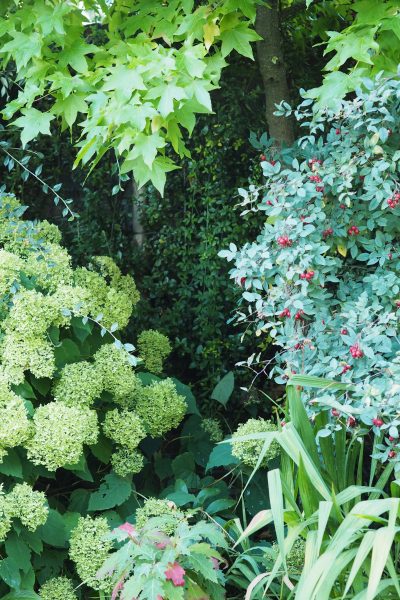
There’s still lots of green in September – I particularly love this combination of leaf shape and colour in my ‘shady’ bed. Clockwise from top: liquidambar, rosa glauca, crocosmia, hydrangeas ‘Hot Chocolate’ then ‘Annabelle’. It’s pyracantha in the background. I didn’t plan it – it evolved over years. If a plant is happy in a shady north-facing border, then it seems to be very little trouble.
Mistake no 7 – not understanding what the specific plants need
We don’t all have to be experts, but if there’s a particular type of plant you love, then it’s worth finding out more about it. Labels on plants are often fairly cursory and general. Sometimes plants are more flexible than the label suggests and will thrive in a wider variety of conditions. Sometimes not.
So, if you love dahlias, I can recommend Naomi Slade’s book Dahlias, published by Pavilion Books. Learning more about where a plant has come from and how it’s developed really does help in understanding where and how it will do well in your garden. It also has inspiring photos of particularly beautiful dahlia varieties, taken by Georgianna Lane.
( Note: you can buy Dahlias online via this link. Links to Amazon are affiliate links so I may get a small fee if you buy. But it doesn’t affect the price you pay. Other links are not affiliate.)
A new home-made table
Enough of the self-flagellating mistakes for a while. Let’s celebrate what we’re really enjoying in the September garden. Mr Middlesize has made us a new table for the pergola.
Last year, we roofed the pergola with corrugated iron to make it an all-weather space, but couldn’t find the right size table for it.
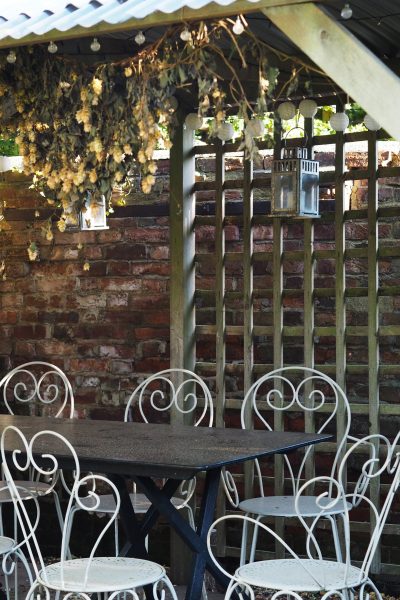
We can now seat eight under the corrugated iron roof of the pergola. The table is painted in Farrow & Ball’s Black Blue, to match our front door, back door, log store, bin store and shed.
So Mr Middlesize made one with a ply top and trestle legs (he did make the legs in order to get the proportions exactly right). I thought of doing a ‘how-to’ but it’s more complicated than it sounds. You need DIY skills. And if you have those, you probably know of better ‘how to’ carpentry sources than a gardening blog.
But it may be useful to know that he used high quality marine-grade 12mm ply in 4ftx8ft sheets for the top, with pine battens so that the table wouldn’t bend or buckle. To make the trestle legs, he used the same ‘two-by-one’ pine battens (because they measure 2″x 1″ or, more correctly, 21mm x 44mm). Sometimes called PSE (Planed Square Edge). The total cost was under £100. And it took Mr M around three days, including researching how to do it and finding the materials.
You can buy the marine ply online, but it’s quite a lot cheaper to go to local builder’s merchants to buy it in person as it’s expensive to deliver.
A new look for the garden chairs
We had two sets of garden chairs. Ten years ago I painted one set in Farrow & Ball’s Hardwick White. The other is standard garden-centre green. So I painted the green ones in Hardwick White to match them all up.
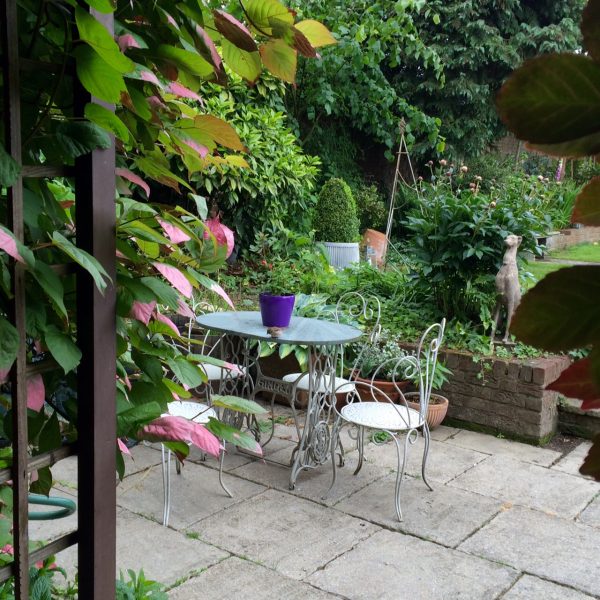
I painted these vintage French chairs in F&B Hardwick White ten years ago. They are kept outside all year, but still look good. Now I’ve painted some standard garden-centre chairs to match.
If you use a Farrow & Ball paint, you need a first coat of Farrow & Ball metal primer. Or you can use chalk paints, which go on any surface (wood, metal, plastic) without a primer.
It’s worth saying that, after ten years, the Farrow & Ball painted chairs are still looking good and don’t need any touch-ups. They’ve been out in all weathers.
Salvias are a garden saviour
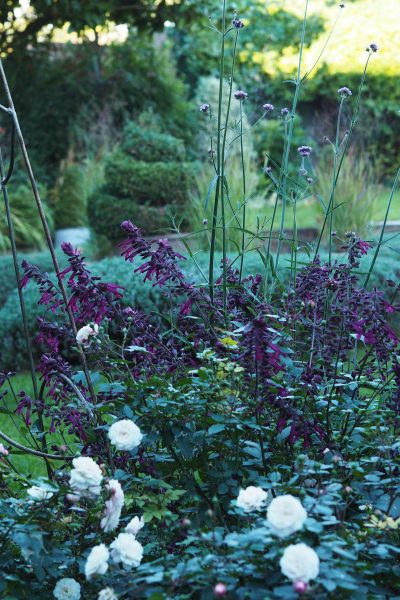
Salvia ‘Love & Wishes’ is now planted, and has a wonderful second flush of flowers.The small white roses in the foreground are ‘Cecile Brunner’ (the secateur pruned side).
I haven’t grown many salvias before, but they really earn their place in the September garden. I bought these three pots of Salvia ‘Love & Wishes’ to cheer up my display of pots when we were open for Faversham Open Gardens in June. They spent two months in their pots, then I clipped back their flowers and planted them in the border. (Subsequently, I read that you shouldn’t dead-head salvias – or am I dreaming that?)
I’d been warned that you can plant perennials at almost any time, but if you plant them in summer, then you really do have to water them as if they were still in pots. I suspect that’s another piece of gardening advice that can never be ignored – especially this summer. I watered regularly and they have rewarded me with a truly wonderful second flowering.
In the background you can see the low blue mounds of clipped lavender. We pruned it in late July this year, but in other years, I’ve left it as late as early October. The advantage with a late July pruning is that we have the lovely blue leaf colour. Last year’s late-pruned lavender was brown until March (here’s why lavender can be pruned ‘into the brown’).
More September garden in the video
There’s a full tour of the garden in this video, as well as a look at Naomi Slade’s ‘Dahlias’,
Pin for reference
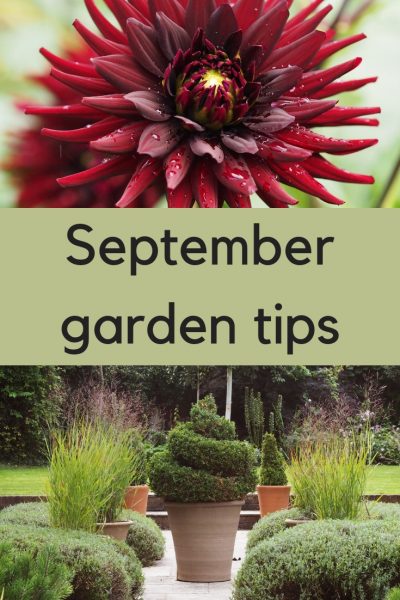
























Being in the south like you, I left dahlias in for the first time last year. The mulch was scattered everywhere by cats and squirrels but it didn’t seem to have a negative effect. The dahlias still came back bigger and better than before! Also delighted that someone else grows Salvia ‘Love and Wishes’ – mine has been a star having being droughted whilst on holiday but it bounced back with a little tic.
Glad to hear Love & Wishes will survive some drought – I’ve been coddling mine because it’s in its first year, but I don’t water once plants are established.
I’m quite guilty of mistake number seven especially when I was still new to gardening (not that I’m trying to justify my mistake). But as I gained more experience, I was able to figure out that not all plants are created equal and that some of them may need more or less of something than others.
Great post!
Thank you – one kind person has suggested that we should call these ‘learning experiences’ rather than mistakes…
I must agree about the Dahlias. Mine also have suffered badly this year – with the exception of Rip City which is a complete thug and has now collapsed untidily. Memo to self: stake it more throughly next year and give half of the tubers away as two of Rip City are quite enough!
I’m interested to hear that Rip City is a thug in your garden too.
I think your orange dahlia might be “Orange Cushion”. Bought some years ago from SR and looks very very similar.
Thank you, that’s very helpful – I definitely bought it from Sarah Raven and also some years ago. I’ve now Googled Orange Cushion and it looks as if you’re definitely right.